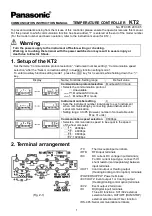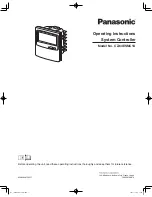
Instruction Manual
D200124X012
2500 and 2503 Controllers/Transmitters
June 2017
12
Top‐Mounted Sensor
CAUTION
If inserting the displacer into the vessel before attaching to the displacer rod, provide a means of supporting the displacer
to prevent it from dropping into the vessel and suffering damage.
Figure 7 shows an example of a top‐mounted cageless sensor. You may attach the displacer to the displacer rod before
installing the sensor on the vessel. If the displacer diameter is small enough, you may install a long or sectionalized
displacer through the sensor head access hole after the sensor is installed on the vessel. Connect the displacer as
shown in figure 8, locking the assembly with the cotter springs provided. If a stem extension is used between the
displacer spud and the stem end piece, make sure the nuts are tight at each end of the stem. Install and tighten
suitable cap screws in the flanged connection to complete the installation.
A special travel stop may be provided on top‐mounted sensors to aid in servicing of the sensor. This option prevents
dropping the displacer and stem when the displacer rod is disconnected.
Supply and Output Pressure Connections
WARNING
To avoid personal injury or property damage resulting from the sudden release of pressure, do not install any system
component where service conditions could exceed the limits given in this manual. Use pressure‐relieving devices as
required by government or accepted industry codes and good engineering practices.
CAUTION
Do not use sealing tape on pneumatic connections. This instrument contains small passages that may become obstructed
by detached sealing tape. Thread sealant paste should be used to seal and lubricate pneumatic threaded connections.
Figure 9 shows dimensions, locations, and connections for controller/transmitter installation. All pressure connections
to the controller/transmitter are 1/4 NPT internal.
Supply Pressure
WARNING
Personal injury or property damage may occur from an uncontrolled process if the supply medium is not clean, dry, oil‐free
air, or noncorrosive gas. While use and regular maintenance of a filter that removes particles larger than 40 micrometers in
diameter will suffice in most applications, check with an Emerson Automation Solutions field office and industry
instrument air quality standards for use with corrosive air or if you are unsure about the proper amount or method of air
filtration or filter maintenance.
Supply pressure medium must be clean, dry, and noncorrosive and meet the requirements of ISA Standard 7.0.01 or
ISO 8573-1. A maximum 40 micrometer particle size in the air system is acceptable. Further filtration down to 5













































